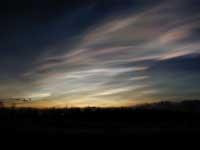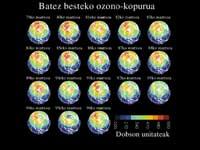Orifice of the
In 1970 scientists first discovered that the ozone layer on Antarctica was thinning and deteriorating. The British team of researchers was dedicated to monitoring the atmosphere and ozone layer of Antarctica during those years, when the seriousness of the problem impacted them. Examples of this severity are some of the anecdotes that have occurred in those early studies. When researchers measured the decrease in ozone level in 1985, the loss was so pronounced that they thought the meters were deteriorating. The devices were modified and the measurements were reperformed, obtaining the same values that were obtained a few months earlier. The measuring devices were fine, not so the ozone layer of Antarctica.
... The serious ozone layer situation was surprising for researchers, but the initial surprise quickly became research. Numerous human and technological resources were used for the study of the ozone layer and soon those responsible for the catastrophe were discovered: the chlorofluorocarbons used for years in aerosols and refrigerators, that is, the famous CFCs.

The measures to limit the use of these compounds were immediately agreed and by 1996 it pledged in Montreal to halve CFCs emissions (and this year stop using them) in 1987. If we comply with the agreement, we would again protect healthy ozone layers by 2050, even though some recent studies have announced a slower than expected solution.
From Antarctica to the Arctic
Although the hole in the ozone layer above Antarctica has been mentioned so far (which in some areas is only minute), the North Pole also has its median zone. For years the European Union (with the THESEO program) and the United States (with the SOLVE program) are studying the evolution of the ozone layer in the Arctic, and the data that have been released throughout this month have generated great concern among researchers. It seems that the Arctic ozone layer has lost 60% of its thickness in this winter, the biggest loss of the 1990s.
According to the researchers, the effects of this mining will be noticed in Europe in the spring we have just started, especially in Britain, Belgium, Holland, Denmark and northern Germany. These impacts are also known and of great importance. The first effect of thinning the ozone layer is the increase in ultraviolet radiation reaching the Earth's surface and it has been shown that this generates health problems. A 1% decrease in ozone concentration has been found to cause a 5% increase in benign skin tumors and a 1% increase in lethal cancers. In addition, it increases the risk of eye diseases, inhibits the immune system and increases the likelihood of contracting diseases from herpes, hepatitis and parasites. And all this in what touches us directly to human beings.
Their influence on plants and their possible changes in ecological balance are also spectacular. The importance of the ozone layer and the need to protect yourself from the Sun are not at all banal words!
Why at the poles?
So far we have talked about the reduction of the ozone layer in Antarctica and the Arctic, since it is in both areas where this phenomenon is particularly appreciated. It is, on the other hand, a rather paradoxical phenomenon, since in these two regions hardly live people who will issue CFCs. That is, a troubled world! There is no one to contaminate and all the problems are there. If you prefer, but as you may have suspected, the thinner areas of the ozone layer are not at the poles because chance has wanted it; the presence of this geographical situation of the holes has its explanation, an explanation that aggravates the problem of reducing the ozone layer and increases our concern.
The ozone layer is the ozone layer present in the atmosphere at altitudes between 10 and 50 km (the highest concentration is at an altitude of 25 km) that occupies approximately the region of the atmosphere called stratosphere. There are no clouds in the stratosphere, except in very cold regions, that is, around the poles. When the temperature drops below 80ºC, clouds above 20km of altitude form. However, these clouds are not formed by drops of water and, given their special composition, have a special behavior: under these clouds, the components of the CFCs suffer intense reactions and the derivatives that are generated destroy the ozone layer. As a mathematical equation: The disappearance of the ozone layer as well as the CFCs plus stratospheric clouds. This destruction also occurs at an altitude between the maximum and most important thickness of the ozone layer, between 20 and 25 km.

That is why we have holes in the poles and not anywhere else. However, these clouds that originate near the north and south poles only occur in winter when temperatures are very low. In spring, when the temperature rises again, the clouds disappear and the thickness of the ozone layer recovers. However, in the last half century we have emitted too many CFCs into the atmosphere and have turned the slimming/fattening cycles upside down. In Antarctica, for example, the ozone layer has been completely destroyed in some places. In the North Pole the problem has never been so serious, as its stratosphere is hotter.
But the latter is also changing. In recent years, low abnormal temperatures have been measured in the North Pole, with extraordinary ozone losses. And even if it seems surprising, the greenhouse effect can be responsible for those low temperatures. That is, the same effect that warms the planet cools the stratosphere. It seems that the carbon dioxide that accumulates in the lower layers of the atmosphere causes the warming of these layers, while cooling the upper layer (to equalize it or).
Although this process cannot yet be ensured, more than one research has addressed the hypothesis. If this were proven, the greenhouse effect and ozone layer loss would no longer be independent problems. But not only that, the greenhouse effect could considerably increase the recovery times of the ozone layer. The stratospheric winters of 1995, 96 and 97 were very cold and the ozone pile disappeared.
Those of 1998 and 1999 were very hot and ozone levels remained fairly constant. This year's winter has been very cold again and the Arctic has lost 60% of the ozone layer. The data of 6 winters are not enough to complete the pattern of behavior, but to generate strong suspicions.
The greenhouse effect againWhen we talk about many of the Earth's environmental problems (but not those responsible), the greenhouse effect usually appears in most cases at the top of the list. The greenhouse effect is causing a global climate change that has multiplied avatars, floods, droughts and other catastrophes. So far it seemed that the ozone layer was one of the few general environmental problems that had nothing to do with the greenhouse effect. Excess ozone in the lower layers of the atmosphere increases the greenhouse effect, but ozone in the upper layers protects us from the harmful radiation of the Sun. Ozone is essential above 15 km and very harmful below. This duplicity has generated confusion in people, but not in researchers. These have always analyzed as independent problems the greenhouse effect and the loss of the ozone layer. The vinocre is destroyed by the CFCs and the clouds of the polar regions are a great protection for these destructive reactions. However, the latest research has added to the destruction process a third factor, the greenhouse effect. Greenhouse effect that warms the lower part of the Atmosphere that needs more cold and cools the upper part of the atmosphere that needs more heat. It is a joke of bad taste. It seems that the recovery of ozone layers will take longer than is calculated. The greenhouse effect increases ozone destruction and slows recovery. The big problem of two factors to control can become a tremendous problem of three factors. |
Published in the supplement Natura de Gara
Buletina
Bidali zure helbide elektronikoa eta jaso asteroko buletina zure sarrera-ontzian











